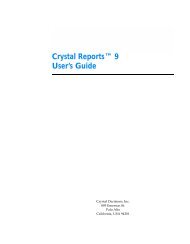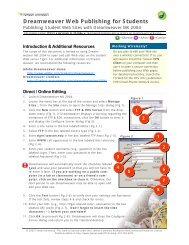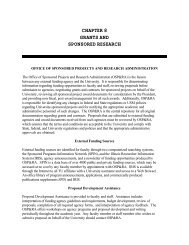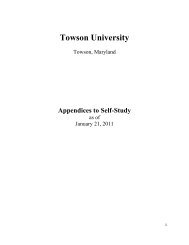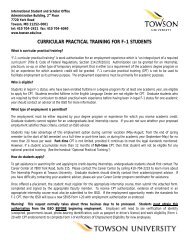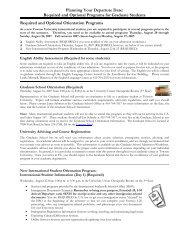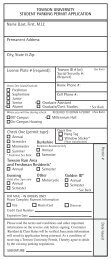Guidelines For the Safe Use & Disposal Of Ethidium Bromide
Guidelines For the Safe Use & Disposal Of Ethidium Bromide
Guidelines For the Safe Use & Disposal Of Ethidium Bromide
Create successful ePaper yourself
Turn your PDF publications into a flip-book with our unique Google optimized e-Paper software.
Department of Environmental Health & <strong>Safe</strong>ty<br />
Phone: (410) 296-7593<br />
Fax: (410) 296-5076<br />
Emergency: (410) 704-2133<br />
Email: <strong>Safe</strong>ty@towson.edu<br />
Website: http://wwwnew.towson.edu/adminfinance/facilities/ehs<br />
July 2005<br />
<strong>Guidelines</strong><br />
<strong>For</strong> <strong>the</strong><br />
<strong>Safe</strong> <strong>Use</strong> & <strong>Disposal</strong><br />
<strong>Of</strong> <strong>Ethidium</strong> <strong>Bromide</strong>
<strong>Ethidium</strong> bromide (EtBr) is a potent mutagen that has been used for many years for <strong>the</strong><br />
visualization of nucleic acids in agarose gels. This material fluoresces a red-orange color<br />
under ultraviolet light and with increased fluorescence when bound to double-stranded<br />
DNA. EtBr is typically purchased in powder or solution form and is soluble in water. The<br />
crystal or powder form is odorless and appears dark red in color.<br />
The powder form is considered an irritant to <strong>the</strong> upper respiratory tract, eyes and skin.<br />
EtBr is strongly mutagenic, causing living cell mutations. Even though <strong>the</strong>re is no evidence<br />
at this time of human carcinogenicity or teratogenicity, this material should be considered<br />
a possible carcinogen or teratogen and all possible precautions taken to minimize<br />
potential exposures. While it is not specifically listed as a hazardous waste, its mutagenic<br />
properties may present a hazard if not managed properly.<br />
When purchasing EtBr make sure that you purchase <strong>the</strong> smallest amount possible for your<br />
use. Stock quantities of unused EtBr should be returned to <strong>the</strong> supplier if possible. You<br />
should also check with o<strong>the</strong>r investigators in your area to see if <strong>the</strong>y could use <strong>the</strong><br />
product. When all o<strong>the</strong>r means of distribution have been eliminated <strong>the</strong>n you should call<br />
Environmental Health & <strong>Safe</strong>ty (EHS) to pick-up <strong>the</strong> unused product for disposal.<br />
I. Personal Protection Equipment (PPE)<br />
SAFE USE<br />
As in any laboratory, never eat, drink, smoke, handle contact lenses or apply cosmetics<br />
where EtBr or o<strong>the</strong>r chemicals are present. An operational emergency eyewash and<br />
shower should be immediately accessible. Wear a lab coat with sleeves rolled down,<br />
chemical splash goggles (NOT safety glasses), and nitrile disposable gloves when working<br />
with concentrated EtBr. Even when working with diluted concentrations, nitrile gloves<br />
should always be worn. Never re-use disposable gloves. Leave lab coats, gloves, and o<strong>the</strong>r<br />
Personal Protective Equipment (PPE) in <strong>the</strong> lab when your work is complete. To prevent<br />
<strong>the</strong> spread of this or o<strong>the</strong>r chemicals outside of <strong>the</strong> lab, EtBr users should also wash <strong>the</strong>ir<br />
hands thoroughly with soap and water after removing <strong>the</strong>ir gloves, even if <strong>the</strong>y are certain<br />
<strong>the</strong> gloves weren't punctured.<br />
Confine all work with dry EtBr to a properly functioning, uncluttered chemical fume<br />
hood - be sure <strong>the</strong> hood sash is at <strong>the</strong> correct height (< 12 inches). Also, consider using<br />
pre-mixed solutions or pre-measured quantities. As with all hazardous substances, work<br />
on a disposable mat in <strong>the</strong> hood, and dispose of used mat properly after work is done.<br />
Whenever weighing dry EtBr, use a chamber or enclosed weighing station to<br />
reduce/eliminate cross drafts which can affect <strong>the</strong> performance of <strong>the</strong> scales and also<br />
eliminate <strong>the</strong> potential for airborne contamination.<br />
2
If an ultraviolet (UV) light source is used in your work with EtBr, added caution is<br />
required. As a general rule, avoid exposing unprotected skin and eyes to intense UV<br />
sources. If <strong>the</strong> UV light is aimed upwards, wear goggles or glasses rated for UV short<br />
wave lengths when you are standing near <strong>the</strong> source. <strong>For</strong> prolonged work close to UV<br />
light boxes or o<strong>the</strong>r intense sources, it may be useful to wrap <strong>the</strong> end of <strong>the</strong> lab coat<br />
sleeves loosely with masking tape to prevent gaps where <strong>the</strong> wrist could be exposed. <strong>For</strong><br />
low-intensity UV sources, <strong>the</strong> requirement for UV protection can be waived if <strong>the</strong><br />
exposure to personnel has been measured and shown to be within permissible exposure<br />
levels. Contact <strong>the</strong> Radiation <strong>Safe</strong>ty <strong>Of</strong>fice (RSO) in EHS at 410-296-7593 if you need<br />
measurements of <strong>the</strong> UV levels in your lab.<br />
II. Work Practices<br />
When working with EtBr, try to minimize <strong>the</strong> potential for spills. Where practical,<br />
purchase ready-made stock solutions from chemical manufacturers in lieu of mixing your<br />
own solutions. If you prefer to mix your own solutions of EtBr, protect yourself by doing<br />
this process in an operable fume hood with <strong>the</strong> sash at <strong>the</strong> correct height. Perform all<br />
processes that may generate EtBr dusts or mists inside <strong>the</strong> fume hood to minimize<br />
inhalation exposures. Prevent accidents by keeping container sizes and quantities in <strong>the</strong><br />
work area as small as possible and transporting small quantities of EtBr in a secondary<br />
container instead of carrying large quantities. Keep EtBr containers tightly closed when<br />
not actively pouring to or from <strong>the</strong> container. Whenever you transport gels, always use<br />
secondary containment (i.e., basins or trays) to contain spills and prevent building<br />
contamination.<br />
All non-waste EtBr containers must be labeled in accordance with Federal and State<br />
Right-to-Know regulations. At a minimum, all EtBr containers must contain <strong>the</strong> following<br />
information:<br />
• Name of <strong>the</strong> material<br />
• Concentration<br />
• Warnings<br />
• Date solution was prepared, if appropriate<br />
• Preparer’s initials, if appropriate.<br />
Employees and students working with EtBr should be familiar with <strong>the</strong>se procedures and<br />
trained on its proper use, disposal and hazards by Principle Investigators prior to use.<br />
3
III. Spill Procedures<br />
In case of a small (1 gallon), immediately notify all lab personnel and evacuate <strong>the</strong><br />
lab immediately. Post warning signs on all lab doors notifying o<strong>the</strong>rs of <strong>the</strong> spill. If<br />
possible, try to contain <strong>the</strong> spill to prevent it from flowing down drains, under cabinets,<br />
etc. Do not track EtBr out of <strong>the</strong> immediate spill area. Contact EHS and prevent<br />
unnecessary entry into <strong>the</strong> room until EHS personnel arrive. Stand by to assist EHS in <strong>the</strong><br />
clean-up.<br />
IV. Emergency Procedures<br />
If EtBr contacts <strong>the</strong> eyes, immediately flush <strong>the</strong>m with copious amounts of cold water for<br />
at least 15 minutes. (If it is available, an emergency eyewash is <strong>the</strong> best and safest way to<br />
do this.) <strong>For</strong> skin contact, remove contaminated clothing and immediately wash <strong>the</strong><br />
affected area with soap and copious amounts of cold or cool water. If a person inhales<br />
EtBr dust, move <strong>the</strong>m to fresh air. After any eye or internal exposure (inhalation or<br />
ingestion) to EtBr, <strong>the</strong> affected person should immediately seek medical evaluation.<br />
4
Waste <strong>Disposal</strong><br />
Unwanted solid EtBr, gels, and all working solutions must be disposed of through EHS.<br />
<strong>Disposal</strong> of EtBr via sink drains is strictly prohibited. Working solutions can be disposed<br />
of through EHS or may be rendered non-toxic as <strong>the</strong> last step of your experimental<br />
process.<br />
Separate EtBr liquid waste from solid waste and place into separate waste containers and<br />
ensure that:<br />
• Each waste container has a hazardous waste label (available from EHS) which is<br />
dated with <strong>the</strong> date waste is first placed into <strong>the</strong> container and legibly lists all<br />
waste ingredients (including water) and approximate concentrations.<br />
(Concentrations must total 100 %.)<br />
• If potentially corrosive (pH12.5), list pH on hazardous waste label.<br />
• All hazardous waste containers are tightly closed except when actively adding<br />
waste to <strong>the</strong> container.<br />
• All EtBr waste containers are stored in appropriately sized secondary containment<br />
devices (SCD’s). (Appropriately sized is defined as capable of containing 100% of<br />
<strong>the</strong> total waste volume contained by <strong>the</strong> SCD OR 100% of <strong>the</strong> capacity of <strong>the</strong><br />
largest container stored within [whichever is greater].)<br />
I. Electrophoresis Gels<br />
Prior to <strong>the</strong> disposal of gels, separate <strong>the</strong> high concentration gels<br />
(>0.5micrograms/milliliter [µg/ml] EtBr) from <strong>the</strong> low concentration gels (0.5µg/ml”) hazardous waste container for disposal by<br />
EHS when full. Don’t forget to date <strong>the</strong> hazardous waste label with <strong>the</strong> date waste<br />
is first put into <strong>the</strong> container. Wherever possible, high concentration gels should be<br />
allowed to thoroughly dry by evaporation prior to disposal in order to reduce<br />
disposal cost (charge is by weight).<br />
• It is not necessary to dry <strong>the</strong> low concentration gels (
II. Aqueous Solutions<br />
Stock, rinse and wash solutions can be decontaminated or deactivated using <strong>the</strong> following<br />
methods or use <strong>the</strong> procedures published in <strong>the</strong> National Research Council's report,<br />
Prudent Practices in <strong>the</strong> Laboratory: Handling and <strong>Disposal</strong> of Chemicals, or in o<strong>the</strong>r<br />
peer-reviewed scientific journals. EHS strongly recommends <strong>the</strong> charcoal filtration<br />
method of disposal.<br />
Please Note: These procedures ONLY apply to aqueous EtBr solutions. EtBr solutions<br />
containing o<strong>the</strong>r regulated hazardous wastes can not be treated and MUST be disposed of<br />
through EHS.<br />
1. Charcoal Filtration:<br />
Filtering aqueous EtBr waste solutions through a bed of activated<br />
charcoal is a relatively simple and effective way to remove EtBr. The<br />
filtrate is non-hazardous and may be poured down <strong>the</strong> drain. There<br />
are two commercially available kits available for <strong>the</strong> filtration of<br />
aqueous EtBr wastes.<br />
A. S&S Funnel Kit: This kit is available through VWR<br />
(VWR#28165-502) and uses a funnel and packaged<br />
charcoal disk to filter up to 10 liters of aqueous EtBr<br />
waste. Once <strong>the</strong> filter has expired, it should be<br />
packaged in a sealed bag (i.e., Zip-Lock) and disposed<br />
of through EHS.<br />
To extend filter life, keep funnel covered when not in use.<br />
6
2. Chemical Deactivation<br />
B) Bio 101 “EtBr Greenbag <strong>Disposal</strong> Kit: This kit is available<br />
through BIO 101” (#2350- 200) and uses a charcoal “tea bag” to<br />
remove EtBr from aqueous waste solutions. The used “tea bag” is<br />
packaged into a sealed bag (i.e., Zip-Lock) and disposed of through<br />
EHS. One kit has <strong>the</strong> capacity to remove 500mg of EtBr from<br />
solutions (10mg EtBr/bag).<br />
Chemical deactivation is not <strong>the</strong> preferred disposal method. However, if<br />
you choose to detoxify EtBr in your laboratory, hazardous waste<br />
regulations require that you perform <strong>the</strong> procedure at or near <strong>the</strong> point of<br />
EtBr use and waste generation (i.e., same room). Solutions containing EtBr<br />
can be deactivated and rendered non-hazardous by using <strong>the</strong> following<br />
method. Deactivation may be confirmed by using UV light to detect<br />
fluorescence.<br />
A. Lunn & Sansone Method: <strong>For</strong> each 100 ml of<br />
aqueous EtBr solution:<br />
• Add 5% hypophosphorous acid.<br />
• Add 12 ml of 0.5 M sodium nitrite.<br />
• Stir briefly and let stand for 20 hours.<br />
• Adjust pH to 7-9 using sodium hydroxide.<br />
• Pour down drain with copious amounts of water.<br />
7
III. Crystals & Powders<br />
Dispose of old or unwanted containers of EtBr crystals or powders as regulated hazardous<br />
waste through EHS.<br />
IV. Contaminated Solids<br />
Contaminated solids consist of gloves, paper towels, bench paper and o<strong>the</strong>r nonhazardous<br />
labware items and should be collected for disposal as a regulated hazardous<br />
waste through EHS. Solid waste containers must not contain any liquids. EHS has<br />
appropriate solid waste disposal containers.<br />
V. Contaminated Labware<br />
Potentially dangerous needles, scalpels, pipettes and o<strong>the</strong>r sharps contaminated with EtBr.<br />
Contaminated sharps must not contain any liquids and should be disposed of directly into<br />
an approved sharps container.<br />
Disposable glassware incidentally contaminated with EtBr should be disposed of in a<br />
puncture resistant broken glass container and disposed of as non-regulated domestic<br />
waste. (Incidentally contaminated is defined as no visible contamination but has been in<br />
contact with EtBr solids or solutions.) Grossly contaminated (visibly contaminated)<br />
glassware should be washed with bleach before disposal in a broken glass container.<br />
Centrifuge and test tubes contaminated with EtBr should first be emptied and <strong>the</strong> liquid<br />
disposed of in accordance with <strong>the</strong> procedures above. Empty incidental tubes can be<br />
disposed of as non-hazardous domestic waste. Grossly contaminated (visibly<br />
contaminated) tubes should be collected for disposal with o<strong>the</strong>r contaminated solids as a<br />
regulated hazardous waste through EHS.<br />
VI. Contaminated Equipment<br />
Lab equipment and lab surfaces contaminated with solid EtBr or aqueous solutions of<br />
>0.5µg/ml EtBr should be thoroughly decontaminated prior to re-use using <strong>the</strong> following<br />
methods:<br />
• <strong>Use</strong> a UV light to locate <strong>the</strong> contamination.<br />
• Prepare a decontamination solution by mixing 4.2 grams of sodium nitrite and 20<br />
ml of 5% hypophosphorous acid in 300ml of water.<br />
• Wash <strong>the</strong> contaminated area with a paper towel soaked in <strong>the</strong> decontamination<br />
solution. Repeat <strong>the</strong> wash with fresh wet paper towels 5 additional times. After<br />
cleaning up, place all <strong>the</strong> used paper towels into <strong>the</strong> unused decontamination<br />
solution and allow <strong>the</strong>m to soak for 1 hour.<br />
8
• Check <strong>the</strong> completeness of <strong>the</strong> decontamination using a UV light. Repeat <strong>the</strong><br />
decontamination procedures with a fresh decontamination solution if any<br />
fluorescence remains.<br />
• Collect and separate contaminated cleanup materials (solids, liquids, etc) for<br />
disposal as regulated hazardous waste through EHS.<br />
V. Waste Minimization<br />
State and Federal hazardous waste regulations require that hazardous waste generators<br />
minimize <strong>the</strong> generation of hazardous wastes. As an EtBr generator, it is your<br />
responsibility to minimize wherever possible, <strong>the</strong> generation of EtBr wastes. The following<br />
are suggestions for minimizing EtBr wastes:<br />
• Wherever possible, substitute less or non-toxic stains for <strong>Ethidium</strong> <strong>Bromide</strong> in <strong>the</strong><br />
identification of DNA<br />
• Recently, new fluorescent dyes have been developed that manufacturers, such as<br />
Molecular Probes Inc. and FMC Bioproducts, claim are less toxic and can detect<br />
nucleic acid components at lower concentrations than EtBr. However, <strong>the</strong>y still<br />
must be handled and disposed of in <strong>the</strong> same manner as EtBr.<br />
• <strong>Use</strong> commercially available EtBr extractors/filters to remove EtBr from buffers and<br />
o<strong>the</strong>r aqueous solutions.<br />
• <strong>Use</strong> dilute ra<strong>the</strong>r than concentrated EtBr solutions wherever possible.<br />
• <strong>Use</strong> micro or semi-micro scale techniques.<br />
9


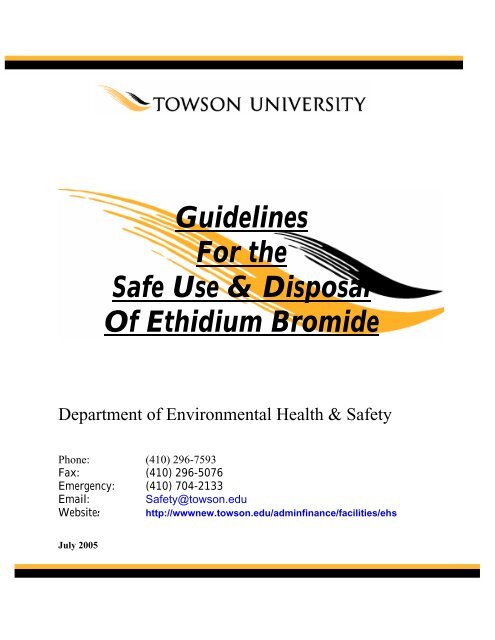
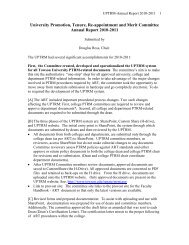
![MEMORANDUM OF UNDERSTANDING [Template] Towson ...](https://img.yumpu.com/51078365/1/190x245/memorandum-of-understanding-template-towson-.jpg?quality=85)
